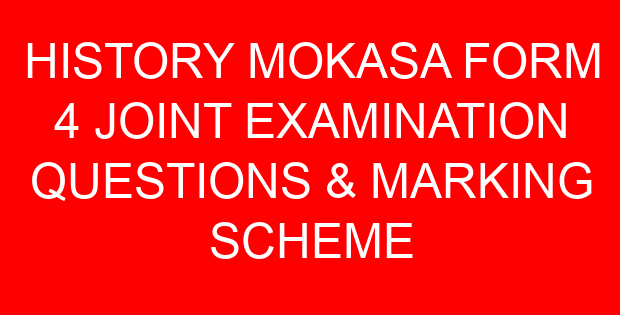HISTORY MOKASA FORM 4 JOINT EXAMINATION QUESTIONS & MARKING SCHEME
311/2
HISTORY AND GOVERNMENT
PAPER 2
TIME: 2½ hours
MOKASA 1 JOINT EXAMINATION EXAM PLUS MARKING SCHEME
Kenya Certificate of Secondary Education
HISTORY AND GOVERNMENT
Paper 2
Section A (25 marks)
- Define the term history. (1 mark)
- It is the study of man’s past activities/events
1 point @ 1 mark (1 mark)
- Identify two methods used by archeologists to date fossils. (2 marks)
- Chemical dating like Radio Carbon (/Carbon 14 method
- Geological periods
- Statistical dating
- Fission Track
- Lexico Statistics
- Stratigraphy
Any 2 point @ 1 mark each (2 marks)
- Name one sub-species of Homo Sapiens. (1 mark)
- Cro Magnon
- Neanderthal man
- Rhodesian man
Any 1 point @ 1 mark each (1 mark)
- Give two characteristics of early agriculture in Europe before the Agrarian (2 marks)
- Small scale farming
- Shifting cultivation
- Subsistence/ peasant farming
- Use of simple tools
- Broadcasting/scattering of seeds
- Use of open field system of farming/Strip farming
- Land belonged to the feudal land lords
- Land was unconsolidated
- They practiced inter cropping
- They practiced common grazing
- They used human and animal labour/no machines
- Poor breeds of crops/animals were raised
Any 2 point @ 1 mark each (2 marks)
- Identify one river responsible for early agriculture in Mesopotamia. (1 mark)
- Tigris
- Euphrates
Any 1 point @ 1 mark each (1 mark)
- Give two shortcomings of barter trade. (2 marks)
- Some commodities are bulky or heavy thus difficult to transport
- It may not be easy to establish exchange rates of commodities/value
- Perishable goods are likely to go to waste if negotiations are not done in time
- It requires coincidence of demand and supply
- Indivisibility of some trade commodities
- It consumes time and energy
Any 2 point @ 1 mark each (2 marks)
- Give two advantages of using a motorcycle as a means of transport. (2 marks)
- They are cheap to acquire and maintain
- They are flexible
- They are readily available
- They are convenient for short distances
Any 2 point @ 1 mark each (2 marks)
- Identify the person who invented the first aeroplane. (1 mark)
- The Wright brothers/Wilbur Wright/Orville Wright
1 point @ 1 mark (1 mark)
- Name two early metals used in industrial development. (2 marks)
- Iron
- Steel
- Bronze
- Copper
- Gold
Any 2 point @ 1 mark each (2 marks)
- Give two advantages of metal tools over stone tools. (2 marks)
- They were durable.
- They could not break easily.
- They could be re- sharpened when blunt.
- Molten metals could be cast into a variety of shapes with patterns and designs on
- Broken objects could be re- worked.
Any 2 point @ 1 mark each (2 marks)
- Identify one early urban centre in Europe. (1 mark)
- Athens
- London
Any 1 point @ 1 mark each (1 mark)
- Give the main reason for the development of Kilwa as an early urban centre. (1 mark)
(i) The control of Sofala gold trade
1 point @ 1 mark (1 mark)
- Identify two communities that took part in the Maji Maji rebellion. (2 marks)
- Matumbi
- Pogoro
- Ngindo
- Mbunga
- Ngoni
- Zaramo
- Luguru
- Sangu
- Wamakonde
- Wamwere
- Ndendeule
- Bena
Any 2 point @ 1 mark each (2 marks)
- Give the main reason why Europeans used scorched earth policy against African (1 mark)
- To weaken them economically, socially and politically
1 point @ 1 mark (1 mark)
- Name two communes in Senegal where the policy of assimilation was applied (2 marks)
- Louis
- Goree
- Dakar
- Rufisque
Any 2 point @ 1 mark each (2 marks)
- Name the policy adopted by France and Britain to avoid the outbreak of another war after the First World War. (1 mark)
- Appeasement policy
1 point @ 1 mark (1 mark)
- Identify the immediate cause of the Second World War. (1 mark)
- German invasion of neutral Belgium
1 point @ 1 mark (1 mark)
Section B (45 marks)
- (a) Identify five hunting methods used by early man. (5 marks)
- Digging pits for them to fall into them
- Using traps/snares
- Chasing them and throwing weapons at them
- Driving animals towards swampy/muddy/water bodies
- Driving animals over cliffs
- Using other animals like dogs
- Chasing animals until they get tired
- Poisoning/drugging the animals
Any 5 points @ 1 mark each (5 marks)
(b) Describe the culture of man in the Middle Stone Age period. (10 marks)
- Man continued hunting and gathering especially big animals
- Man-made tools like hand axes using levallois method.
- Man did fishing on rivers and lakes
- They lived in groups and camps for protection purposes
- They made shelters and also lived in caves.
- They used simple hunting methods of chasing animals and throwing stones at them as well as using traps
- They started wearing animal skins as clothing
- They painted themselves using red ochre and oil
- Distinct language developed to enhance communication
- Rock painting was done on cave walls and rocks.
- They decorated themselves with necklaces made from seeds and animal bones
- Fire was made during this period and was used for a number of purposes like providing warmth during cold seasons
Any 5 points @ 2 marks each (10 marks)
- (a) Identify five methods used to acquire slaves during the Trans-Atlantic slave (5 marks)
- Raids organized by chiefs
- Sale of war captives
- Leaders sold their subjects to enrich themselves/ slaves were exchanged with European products
- They were obtained through kidnapping
- Social misfits were sold
- Through enticement /trickery
- Selling of debtors/ panyarring
Any 5 points @ 1 mark each (5 marks)
(b) Explain five factors responsible for the decline of the Trans-Atlantic slave trade. (10 marks)
- The rise of humanitarian movement in Britain which viewed slave trade as unjust and inhuman e.g. William Wilberforce, James Fox and Thomas Clarkson.
- Leading economists like Adams Smith argued that free people were more productive than slave labour.
- The development of industrial revolution in Britain shifted the demand of slaves to agricultural produce.
- Resistance by Africans both in West Africa and in the new world made the Europeans to abandon the activity.
- The need to discourage mass migration of population from Africa so as to retain market for European manufactured goods.
- The result of American civil war of 1865 won by those opposed to slavery led ending the crucial slave trading/ closure of the slave market in the United States of America
- The coming of Christian missionaries who condemned the activity as unchristian.
- The attainment of independence by the USA in 1776 left Britain without colonies where they could take slaves to work.
- The use of machines in farms and industries rendered slave labour unnecessary.
- Effects from the French revolution of 1789 spread liberty and equality among all thus discouraged slave trade.
- Development of legitimate trade which was more profitable and less costly replaced slave trade and slavery.
- Britain influenced other European countries to stop the slave trade by signing anti slave trade treaties.
Any 5 points @ 2 marks each (10 marks)
- (a) List five traditional forms of communication. (5 marks)
- Drum beats
- Horn blowing
- Messengers/human beings/runners/birds/animals
- Fire and smoke signals
- Gestures and signals/body movements
- Flags
- Bells
- Whistles
- Screams and cries/whistles
- Semaphores
Any 5 points @ 1 mark each (5 marks)
(b) Explain five negative impacts of modern means of communication. (10 marks)
- Some have promoted immorality through watching of pornographic films.
- They have promoted international crime and drug abuse.
- It has encouraged idleness and addiction to programmes by viewers.
- They have created unemployment
- Some are expensive to buy and install
- Some like radios and televisions cause noise pollution
- Some programmes on televisions promote violence
- Prolonged exposure to computer screens cause eye problems
- Mobile phones can cause illnesses through exposure to radioactive rays
Any 5 points @ 2 marks each (10 marks)
- (a) Give five economic activities of the Shona Empire during the pre-colonial (5 marks)
- They grew crops/ agriculture
- They kept livestock
- They traded with Arabs and Swahili traders/ took part in long distance trade/ trade
- They hunted elephants for ivory
- They were iron worked/ blacksmiths
- They made clothes from wild cotton/ bark fibres
- They mined gold
- They were fishermen
- They gathered/ gathering
Any 5 points @ 1 mark each (5 marks)
(b) Discuss the social organization of the Asante Empire in the pre-colonial period. (10 marks)
- The kingdom was composed of many communities who spoke Akan or Twi
- The Asante were organized in clans.
- Marriage between members of the same clan was prohibited. They practiced exogamy and polygamy.
- Inheritance of property was matrilineal.
- The community was bound together by the golden stool.
- There was an annual cultural festival (Odwira) held at Kumasi to honour the
- The society was divided into social classes (social stratification).
- The Asante worshipped many gods and goddesses/polytheists.
- The King, chiefs and Omanhenes were religious leaders (semi divine).
- The ancestors mediated between god and the people.
- They believed in a supreme god called Onyame.
Any 5 points @ 2 marks each (10 marks)
Section C (30 marks)
- (a) Give three methods used by African nationalist in South Africa in their struggle for independence. (3 marks)
- Formation of trade unions to fight for workers’ rights.
- Formation of political parties to air their grievances e.g. ANC
- The use of mass media e.g. radios and newspapers
- Leaders engaged in direct negotiation with the government.
- Many detained nationalists went on hunger strike
- Imposition of economic sanctions by international organizations like U.N.O
- The churches took part in protest demonstrations e.g. the Anglican Church
- Through armed resistance e.g. the armed wing of ANC
- Use of boycotts and strikes against the regime.
- They also organized protests and demonstrations.
Any 3 points @ 1 mark each (3 marks)
(b) Explain six problems encountered by nationalists in Ghana in their struggle for independence. (12 marks)
- The nationalists were arrested/ detained
- The political parties were banned
- The government enacted pass laws which restricted movement thus
- They lacked adequate funds to finance the struggle thus slowing their
- They lacked press freedom making it difficult for them to spread their
- They lacked advanced weapons thereby making them less effective in their armed struggle.
- They had different approaches in their struggle (moderate/radical wings) thus creating a loophole which was exploited by the government.
- Use of divide and rule policy to divide the Africans.
- Rivalry between political parties e.g. CPP and NLDtowards o
Any 6 points @ 2 marks each (12 marks)
- (a) Give three terms of the Berlin Conference of 1884-1885. (3 marks)
- African territories were partitioned thus effective sphere of influence.
- The Niger, Congo, Nile and Zambezi rivers were declared free areas for European navigation.
- The Congo basin was given to Leopold’s (II)’s International African Association..
- The European nations vowed to protect missionaries and traders in their areas irrespective of their nationalities.
- It was unanimously agreed that slave trade be stopped in favour of legitimate
- European powers reasserted their occupation and control of the African
- Nations were encouraged to use peaceful means in solving their differences.
- Any state laying claim of any part of Africa must inform other interested groups.
- The European countries with coastal possessions in Africa could have the immediate hinterland as their sphere of influence.
Any 3 points @ 1 mark each (3 marks)
(b) Explain six results of Buganda collaboration. (12 marks)
- It led to loss of independence.
- It led to introduction of Christianity and European influence in Buganda.
- Islamic influence declined.
- Buganda got protection from external enemies like Bunyoro.
- Kabaka gained recognition and was referred to as His highness.
- Kabakas power was gradually eroded as British administrators gave authority to his officers.
- Buganda was given an advantageous position in the colonial administration and was helped to conquer other communities.
- Buganda advanced more economically than other communities as it acquired European manufactured goods like clothes.
- Buganda benefited from western education and medicine.
Any 6 points @ 2 marks each (12 marks)
- (a) Outline the structure of the League of Nations. (3 marks)
- The Council
- The Secretariat
- The International Court Of Justice
- The International Labour Organization
- The Mandates Commission
- The Assembly
- The Minorities Committee
Any 3 points @ 1 mark each (3 marks)
(b) Explain six causes of the Second World War. (12 marks)
- The rise to power of Adolf Hitler and his determination to restore Germany’s lost
- Unfavourable conditions imposed on Germany by the treaty of Versailles humiliated and made her nurse a grudge against the allied powers.
- The growths of nationalism made countries to be inward looking and therefore were reluctant to participate in international issues.
- The great depression of the 1930s intensified economic instability and forced some countries to practice economic protectionism.
- The inability of the League of Nations to implement its resolutions and punish those who violated them encouraged the aggressors to pursue their objectives/ ambitions and this intensified tension in the world.
- The policy of appeasement practiced by France and Britain encouraged the dictators to carry on with their acts of aggression
- Establishment of alliances between major powers encouraged acts of aggression because of the feeling of mutual support
- The rise of dictators in the 1920’s and 1930’s destroyed democratic rights
- Armament and increased armed forces increased tension contrary to the wishes of the Versailles treaty
- The Spanish civil war (1936 – 1939).
- Territorial violations e.g. in 1935 Italy invaded Ethiopia,
Any 6 points @ 2 marks each (12 marks)




